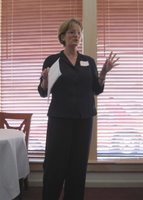By Jody Shee
Your budget may be tight, and your editors may groan at the thought of adding online responsibilities, but once they adjust, it’s not very challenging, and it’s necessary for a publication to thrive.
 The younger generation automatically turns to the Internet for information. When they become the next business leaders, publications can’t afford not to have a strong presence on the web. Online product accounts for only 10 percent of The Kansas City Star’s revenues, but it makes up 90 percent of the daily newspaper’s growth, says Rick Babson, online business editor. He was one of two panelists at the recent Kansas City chapter meeting of the ASBPE on “Putting the web to work.”
The younger generation automatically turns to the Internet for information. When they become the next business leaders, publications can’t afford not to have a strong presence on the web. Online product accounts for only 10 percent of The Kansas City Star’s revenues, but it makes up 90 percent of the daily newspaper’s growth, says Rick Babson, online business editor. He was one of two panelists at the recent Kansas City chapter meeting of the ASBPE on “Putting the web to work.”Though he feels like The Star is in its infancy with the web, Babson has plans for the paper to compete with television news programs as reporters are equipped with video cameras to capture stories and interviews for the web. The Star has built a small room in which to record video programs and eventually will produce a daily morning business report for its website. It has entered into an agreement with a local television station and former television news anchor to go out and shoot stories for the television station, which also will appear on The Star’s site, he says.
Content Ideas
The following are other ways the panelists suggest building Web content, many of which can be used to draw attention to your print product:
- Podcasts work better for some topics than for others. Babson says he’s found that technology and entertainment Podcasts are more popular than general business topics.
- Blogs are a good way to connect with readers and drive traffic to print editions, Babson says.
- A breaking news section is important for publications that serve as industry news leaders. Babson notes that you can include an initial few paragraphs about the story and refer readers to the next print edition for more details. Then, in the print edition, tell readers they can find updates on your website.
- Lengthy documents and reports that you can’t include in print are perfect for your website, Babson says. You can refer to these documents in your print edition. These could include complete meeting reports or legal papers.

- Electronic newsletters are popular and allow you to track results, but make sure you do more with your newsletters than provide links to stories. “You need to have a plan. You need to deliver editorial product. ‘Talk’ to people on a daily basis, don’t just say, ‘Here it is. Go get it,’” says Susan Robinson, director of content management for Sosland Publishing, Kansas City, Mo.
- Offer digital replicas of your print publications. “Weekly magazines are victims of the post office,” Robinson says, adding that international readers will appreciate receiving the digital version in a timely manner. Plus, you can track how it is read. Find a vendor that helps with digital replicas.
- Sell access to research reports, including charts and graphs. “People love that to drop into PowerPoint presentations. We make PowerPoint graphics available,” Robinson says.
- Make photo galleries with captions. Robinson notes that readers love it, and it’s a way for you to use the many photos you can’t include in print. The gallery adds a human element to technical publications.
- Offer article archives and sell access to nonsubscribers who are doing research, Robinson suggests.
Make it work
Before you go crazy with online ideas, Robinson offers these suggestions, many learned through trial and error.
- Serve your readers, not the technology. “Using every bell and whistle on the website is not sustainable,” she says. Remember that you are an information provider first. Think of the best way to serve your readers through the various media. Content, not “being cool,” is king.
- Have a plan. “ ‘If you build it, they will come’ does not work in our business,” Robinson says. To build revenues with your website, you have to know where you want to go with it.
- Develop an editorial calendar for your website. And have it go along with your print edition using much of the same content.
- Repackage some of your content for the Web. For example, compile statistics or profiles.
- Cross-promote your print and Web content to draw traffic to both. It’s not enough to mention your website on a banner or in a house ad in your print product. Include cross references in as many stories as possible.


